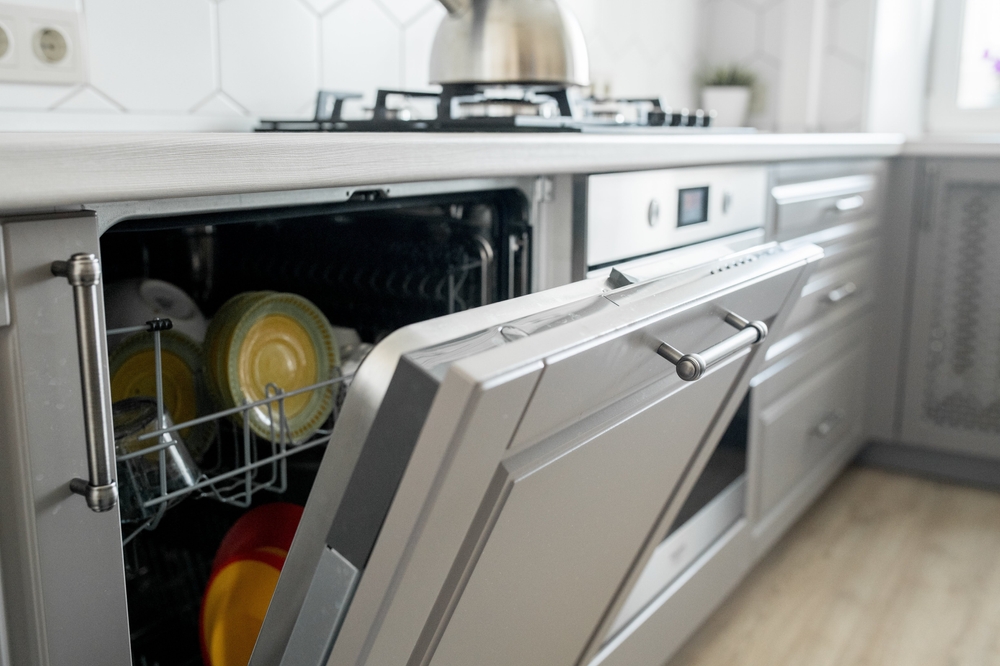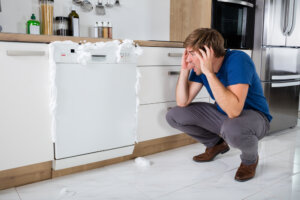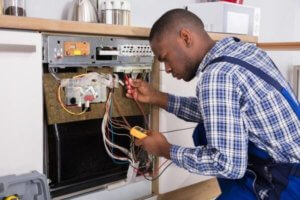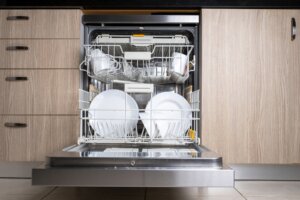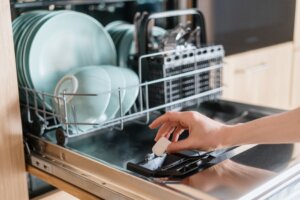Dishwashing machines have been around since the 1800s. They started off as hand-cranked devices made of wood and eventually transformed into the computerized stainless steel or plastic machines we are familiar with today. But, with great technological advances comes great wear and tear. If you wind up with water on the floor as a result of running your dishwasher, you probably have a leak that needs attention. Why do leaks occur, and how exactly can you fix the problem? Read on to find out.
Leaky Doors or Gaskets
Is water leaking directly from your dishwasher door? If the answer is yes, chances are it’s because the seal (gasket) has lost its suction, or has a tear. Dishwasher doors have vinyl or rubber tubing along the frame to keep water from spilling out, and with age and constant use, it’s common for your gasket to crack or loosen. Check for holes by carefully examining the rubber siding. If there are no holes, you can gauge the pressure of the gasket by closing the dishwasher door on a piece of paper. If you can easily pull the paper out of the dishwasher without any resistance, it means that water can leak out, and it’s time to replace the gasket.
Inspect Your Float and Float Switch
The float and float switch are found inside your dishwasher at the bottom of the tub (the switch is below the float). They prevent your machine from overfilling with water, and are triggered to shut off the water inlet valve when the water level reaches a certain point during the course of a washing cycle. However, as you might have guessed, if the float or the float switch become stuck or are faulty, water levels can become too high inside the tub, and will cause your machine to flood. To test if your float is functioning properly, jiggle it up and down when the dishwasher is not in use and listen for a clicking sound. Sometimes, all it needs is a little push to get it working again, but if the problem persists it should be replaced.
Pump Trouble
The pump in your dishwasher is at the bottom of the tub, underneath the spray arm, and its job is to circulate the water during a cycle. Depending on the type of model, it may also drain the excess water after a cycle. During the lifespan of your machine, the rubber or vinyl seal (gasket) around the pump can become brittle and dry from detergent and general wear and tear. Just like the gasket around the front door, your pump’s seal can crack and spring a leak. Look and feel for any signs of damage to the tubing, as you may need to replace it.
While it’s relatively easy to replace your pump seal, the problem could also be with your pump’s motor. Remove the access panel/kick plate below your dishwasher and check for any drips coming from the motor of the pump. If this is the source of the leak, you will need to order a new one that is the right fit for your dishwasher, so check the manufacturer’s website before you buy. Replacing a dishwasher pump and motor is a tricky and intricate process because the wiring connects to your home’s water and power lines, and you will need to pull your machine out from your cabinet to access all the components. So, unless you have done this before, it’s a good idea to call a professional.
Check Your Hoses and Valves
The access panel/kick plate is underneath your dishwasher, and stores your water inlet valve, your drain hose, your circulating hose, as well as various other wires that also connect to your pump. The valve and hoses could be potential sources of the leak if they are old or damaged (typically from general use, but sometimes from mineral build-up and detergents), and you can remove the plate with a screwdriver to check for signs of water.
The water inlet valve supplies water from your home’s main water pipe directly to your dishwasher. If there is a drip coming out of the valve, or if the tubing or valve is loose, cracked or corroded, you should replace it as soon as possible. It is dangerous for water to be exposed to other wires under your dishwasher, and it should not be neglected.
If your water inlet valve is functioning properly, check your hoses for any drips. The drain hose and circulating hose are made of rubber or plastic, and over time can warp. They are secured in place by clamps, and connect to the dishwasher pump. If water is leaking from either hose, you might be able to stop the leak by simply tightening the clamps and making sure the hoses are secured in place. However, if you notice any cracks or tears in the rubber or plastic tubing, or if the clamps are no longer able to grip very well, then you need to swap them for new ones.
Rub-a-Dub-Dub, Mind your Suds
There is a reason why different types of soaps exist for different appliances and uses. Dishwashers run on specific detergents that do not foam or bubble up, unlike regular dish soap. Dish soap is much more concentrated than the soap meant for your machine, so while it’s great for scrubbing your dishes by hand, it’s harmful for your dishwasher and can cause it to fill with foam and overflow. Even pre-washing your dishes with heavy amounts of soap before putting them in the machine can cause the same frothy problems, so it’s better to only rinse your dishes with water.
These are just a few common causes of a leaky dishwasher. It may take some trial and error by checking different places in and around your dishwasher to locate where the water is coming from. The good news is that many manufacturers provide you with an owner’s manual for your appliance, and you can easily search for one online by looking up the model number on the company website. This is helpful when trying to determine what parts might need replacing, and if you need to consult with an expert for any tips or advice on fixing the issue yourself. Remember to always turn the power and water off in your house before doing any repair work, as water and electricity should not mix! Of course, if you haven’t been able to locate the source of your leak, or you need an immediate fix because of some serious water damage, you can always search for a qualified plumber through HomeStars.
